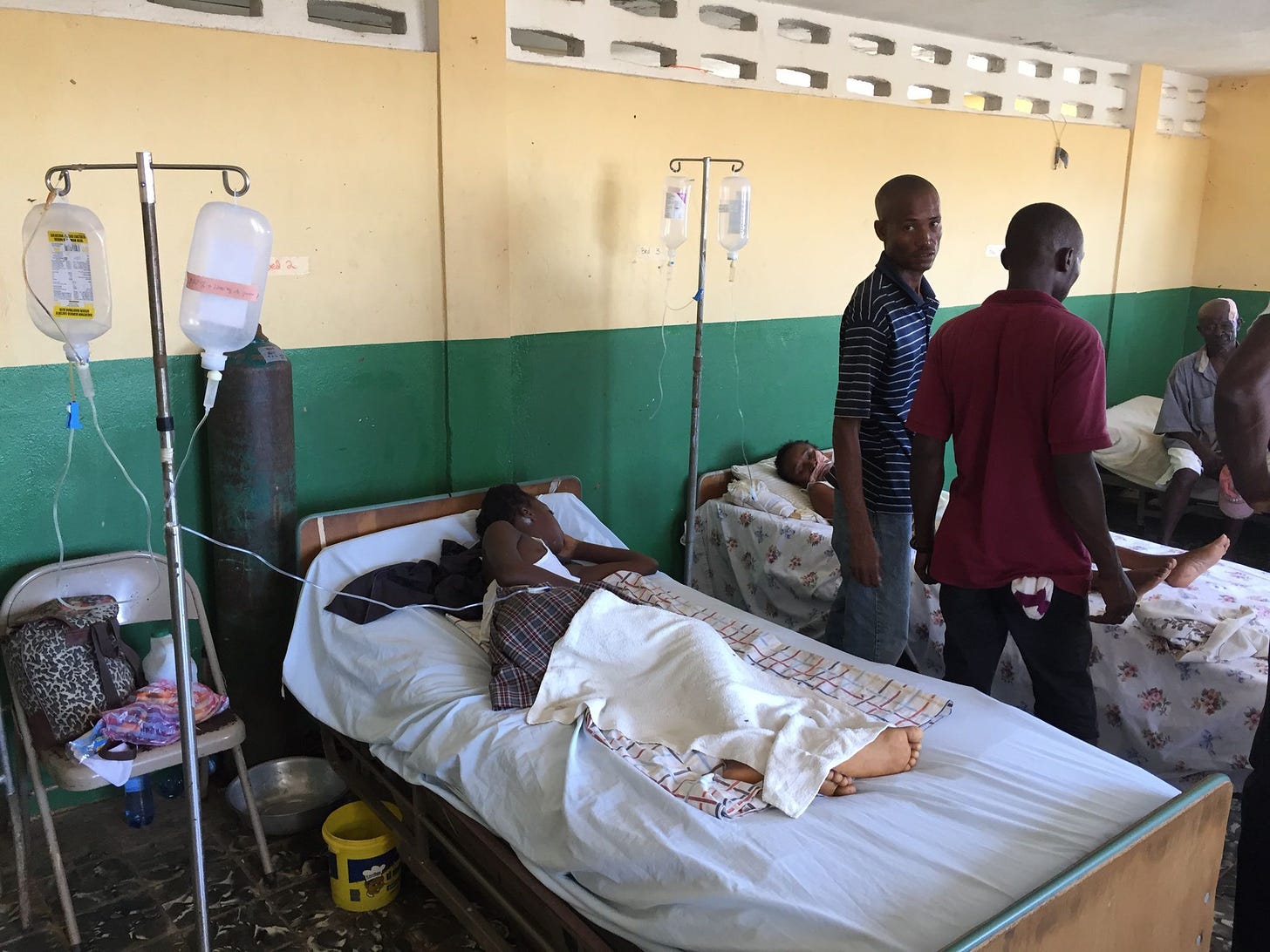This post is also available in: Kreyol
The lesson is that a public health system is never independent of the general functioning of a country—especially a surveillance system.

Photo credit: Etant Dupain
On a warm February morning earlier this year, I was thrilled to learn some fantastic news about Haiti. After years of struggle, the country had come to eliminate cholera. This diarrheic disease acquired principally by ingesting food or water contaminated with the vibrio cholerae bacteria has had a tragic impact on the island. In 2010, a few months after a deadly earthquake killed hundreds of thousands, UN peacekeeping troops stationed along the Artibonite river in central Haiti started the local epidemic. The epidemic had regional consequences as the El Tor strain the UN soldiers imported into the country from South Asia was linked to outbreaks in other countries, including the Dominican Republic, Cuba, and even Mexico.
What followed was a decade of astounding physical and psychological trauma. Nevertheless, with incredible willpower and critical partnerships with international agencies, 12 years later, the Haitian Ministry of Health closed this chapter with relative satisfaction. Hence the announcement and celebrations in February. Unfortunately, the joy of this accomplishment was short-lived. A mixture of misfortune in conjunction with an unstable political situation, major economic setbacks, and the deadly COVID-19 pandemic are likely responsible for the reversal of this significant achievement.
In October 2022, a resurgence of the cholera outbreak was reported in Haiti. There are conflicting reports about the exact number of people affected by this resurgence, but by October 19th, the Ministry of Health had confirmed 23 deaths. The most alarming outbreak is happening now in the largest prison in the country. Questions remain unanswered about why this dreaded specter has reappeared. The National Cholera Surveillance System, established by Haiti’s Ministry of Public Health with support from the CDC, is the focus of most of these interrogations. The surveillance system was and is still instrumental in the fight to eliminate cholera. Despite its efficiency at the start of the epidemic, it is hard to say whether such a system was consistently implemented in Haiti after cases went down.
Daily reporting of cholera cases through the Direction d’Epidémiologie, de Laboratoire et de Recherches (DELR) and microbiological surveillance through the Laboratoire National de Santé Publique (LNSP) allowed Haitian health officials to detect and monitor cases with great accuracy during the first ten years of the epidemic. Surveillance officers trained in Haiti working from 357 sites carried out these crucial daily reports.
From October 2010 to December 2018, the Ministry of Health recorded 820,300 suspected cases and 9,792 deaths. Afterward, cases diminished by 72% in 2018 and 82% in 2019. By August 2020, the decision-makers perceived the decreased incidence of cholera as a victory. However, researchers noted that the underperformance of the passive surveillance system allowed an increased number of cases to go under-reported and a risk of disease resurgence, as published in a Lancet article by Jeannot Francois. Jeannot Francois was the director of the country’s vaccination program (Programme Elargi de Vaccination). Environmental surveillance was not consistent from the start. It lacked funding and effective governance and mainly consisted of various dispersed projects. The Ministry of Health did not communicate any findings to the general population. Haiti’s challenging socio-political context culminating in an explosive situation following the assassination of Jovenel Moise, only worsened these already worrisome structural problems.
Political instability
For about three years before the assassination of Moise, nationwide protests were commonplace, with roadblocks as a strategic mainstay. The circulation of people and goods remains limited in cities and between departments. To make matters worse, armed groups actively control large territories in Port-au-Prince and neighboring towns threatening access to clean water and sanitation.
In 2015, only 52% of Haitians had access to essential water and sanitation facilities, according to the World Bank. I suspect that these figures are even more alarming in sensitive zones. Gun violence, blocked areas, and poor access to all basic services are characteristics of these neighborhoods where the state is absent.
Recently, the national water authorities announced that uprisings and general strikes had disrupted clean water systems. During this “lockdown,” many people resorted to drinking visibly contaminated water. Videos circulated on social media showed people drawing water from taps near the southern exit of Port-au-Prince in an unsanitary environment. Large amounts of toxigenic cholera living in the environment for years were likely being ingested weeks before the announced resurgence. In this unstable context, the Ministry of Health and its network of field epidemiologists doing active surveillance are powerless. No clinical site has been regularly functioning amid severe gang violence and essential resources blockade. Now, any epidemiological investigation can be an overwhelming risk. Therefore, no reliable data can be reported.
Economic setbacks
People in Haiti face stagnant wages, forcing them to leave the public workforce and reducing the state’s ability to maintain motivated disease surveillance teams.
Haiti has been on a path of economic regression that has worsened in the last year. Inflation has reached an unsettling 29%, according to the Institut Haïtien de Statistique et d’Informatique (IHSI). Even more dramatically, the US dollar exchange rate against the national Gourde has been the center of everyone’s attention, reminiscent of past periods of the near-collapse of the Haitian economy.
The ongoing waves of young people fleeing the country are unsurprising. People in Haiti face stagnant wages, forcing them to leave the public workforce and reducing the state’s ability to maintain motivated disease surveillance teams.
Furthermore, the Ministry of Health’s endeavors remain increasingly dependent on outside partnerships. This limits the state’s ability to set priorities on resource allocation independently. The environmental surveillance system remains unfunded while promising young scientists still have no incentive to integrate the scattered projects into a national program.
The COVID-19 pandemic
When the COVID-29 pandemic hit Haiti in March 2020… Staff and funding were moved from one epidemic to the other.
When the COVID-19 pandemic hit Haiti in March 2020, it was 13 months since the last documented case of cholera. The cholera epidemic had not yet been declared over. Complacency in cholera surveillance was rampant among decision-makers and the general population.
COVID-19 was undoubtedly a major public health threat that required a rapid response. An already weak healthcare system had to deal with two major public health threats simultaneously. Staff and funding were moved from one epidemic to the other. In an interesting article about cholera elimination in Haiti, Sophie Cousins cited Jeannot Francois, saying, “In 2019, surveillance practically stopped on cholera… And then in 2020, all resources were redirected to COVID-19.” From this point of view, the COVID-19 pandemic delivered a considerable blow to the frail cholera surveillance system.
Was it premature to celebrate the elimination of cholera in Haiti? Most likely. I acknowledge the incredible work done primarily by Haitian staff with the support of key partners. It is a remarkable achievement to have built a system, albeit imperfect, that has produced admirable results. The lesson is that a public health system is never independent of the general functioning of a country. Especially a surveillance system.
To save lives, the following needs to happen: ensure the urgent availability of clean water and sanitation products in vulnerable areas, roll out education campaigns on the disease, set up rapid response teams, organize vaccination campaigns in target areas, strengthen the care system in the treatment facilities and bolster the active surveillance system and research collaborations.
The conditions for the resurgence of cholera reared their head from the first signs of political instability in 2018, and surveillance suffered greatly. The political instability limits the prospects of a good vaccination campaign also. Just as it jeopardizes the current response, so does it pose grave challenges for improved water and sanitation services for Haitians at the structural level. The country’s economic retraction has also significantly affected, destabilizing response teams and cutting off vital resources. Finally, the COVID-19 pandemic, which was yet another misfortune, undermined efforts at a crucial moment.
Nonetheless, I face the future with calm optimism. Enormous challenges are still present, but Haiti is not starting from zero. The knowledge and the willpower remain.
Feature photo credit: Etant Dupain Subscribe to our free newsletter to keep up with news about Haiti and its diaspora. Consider becoming a paid subscriber to support our work!

Congratulations Keddy, good analysis.